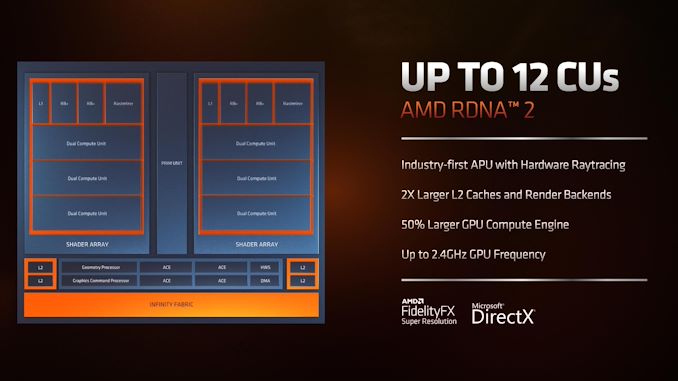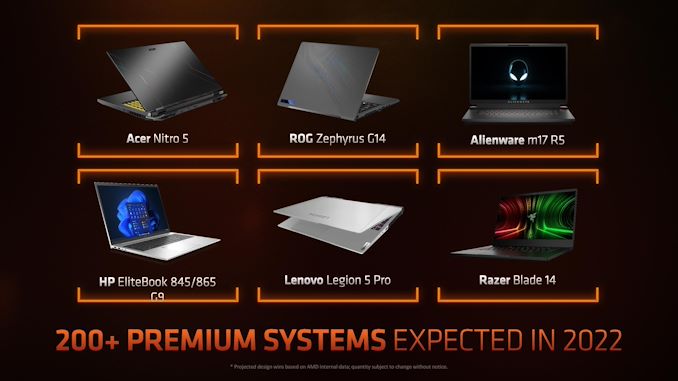AMD Announces Ryzen 6000 Mobile CPUs for Laptops: Zen3+ on 6nm with RDNA2 Graphics
by Dr. Ian Cutress on January 4, 2022 10:43 AM EST-page-011 - Copy_678x452.jpg)
The notebook market is a tough nut to crack with a single solution. People want that mix of high performance at the top, cost effectiveness at the bottom, and throughout there has to be efficiency, utility, and function. On the back of a successful ramp last year, AMD is striking the notebook market hot again in 2022 with the launch of its new Ryzen 6000 Mobile processors. These ‘Rembrandt’ APUs feature AMD’s latest RDNA2 graphics, up to eight Zen3+ cores with enhanced power management features, and it uses TSMC’s N6 manufacturing process for performance and efficiency improvements.
It’s all in the Silicon: Rembrandt is the Code-Name
Yesterday AMD disclosed that they would be launching the new Ryzen 6000 Mobile series today – updated cores, better graphics, more features, all in a single monolithic package a little over 200 mm2. There will be 10 new processors, ranging from the traditional portable 15 W and 28 W hardware, up to 35 W and 45 W plus for the high-end gaming machines. AMD is expecting 200+ premium systems in the market with Ryzen Mobile in 2022.
| AMD Ryzen 6000 Mobile CPUs 'Rembrandt' on 6nm |
||||||
| AnandTech | C/T | Base Freq |
Turbo Freq |
GPU CUs |
GPU MHz |
TDP |
| H-Series 35W+ | ||||||
| Ryzen 9 6980HX | 8/16 | 3300 | 5000 | 12 | 2400 | 45W+ |
| Ryzen 9 6980HS | 8/16 | 3300 | 5000 | 12 | 2400 | 35W |
| Ryzen 9 6900HX | 8/16 | 3300 | 4900 | 12 | 2400 | 45W+ |
| Ryzen 9 6900HS | 8/16 | 3300 | 4900 | 12 | 2400 | 35W |
| Ryzen 7 6800H | 8/16 | 3200 | 4700 | 12 | 2200 | 45W |
| Ryzen 7 6800HS | 8/16 | 3200 | 4700 | 12 | 2200 | 35W |
| Ryzen 5 6600H | 6/12 | 3300 | 4500 | 6 | 1900 | 45W |
| Ryzen 5 6600HS | 6/12 | 3300 | 4500 | 6 | 1900 | 35W |
| U-Series 15W-28W | ||||||
| Ryzen 7 6800U | 8/16 | 2700 | 4700 | 12 | 2200 | 15-28W |
| Ryzen 5 6600U | 6/12 | 2900 | 4500 | 6 | 1900 | 15-28W |
At the heart of the design is AMD’s Zen 3+ core, which affords an improvement in power management between the cores, but keeps the Zen 3 performance characteristics. The focus here is mainly to improve idle power consumption and power when using accelerators, to help extend the life of ultraportable devices – AMD is claiming 15-40% lower power between web browsing and video streaming. There is a frequency uplift as well, with the top processors going up to 5.0 GHz. AMD is claiming up to 1.3x Multi-thread performance for the Ryzen 7 6800U.
This is coupled with 12 compute units of the RDNA2 graphics engine, upgraded from eight Vega units. This is the widest integrated graphics engine that AMD has ever made, with both a +50% increase in units but also a fundamental change in the GPU design - double the graphics cache, double the rasterization performance, double the render backend, and hardware-accelerated ray tracing. The frequency also gets a +20% bump from 2.0 GHz to 2.4 GHz. In gaming performance at 15 W on 5800U vs 28 W at 6800U, AMD is claiming a 1.8-2.0x jump over the previous generation*, and anywhere from 1.2x to 3.0x at 1080p against the competition. Adding on FidelityFX Super Resolution, and AMD suggests another +20-60% in frame rates. This, combined with the memory improvements, should be good for integrated gaming. GPU Rendering performance according to AMD is up to 2.3x faster generationally, but it should be noted however that the GPU does support AV1 decode, both 8-bit and 10-bit streams.
* It should be noted AMD tested the 6800U at 28W nominal TDP, not 15 W
** We originally stated that Rembrandt did not support AV1 based on our interpretation of one of the slides from AMD - we have since confirmed that the chips do support AV1 decode, both 8-bit and 10-bit, supported by AMD's VCN IP inside the chip.
When paired with AMD’s new mobile graphics solutions, the 35W+ series of Rembrandt can feature AMD’s Advantage platform. The idea is that with an A+A design, the system can use SmartShift Max which allows for dynamic power adjustment between CPU and discrete GPU, leading to more performance. This can also be used to extend the battery life, or combined with AMD SmartAccess graphics, can be used to ensure the best GPU is used at all times.
The new Rembrandt CPUs will also feature updated memory controllers, with support up to DDR5-5200 and LPDDR5-6400 – it’s worth noting that there doesn’t seem to be DDR4 support here, thus making a clean cut to the DDR5 standards. (Ian: that might mean increased cost during the first few months of these products.) AMD has also increased from PCIe 3.0 to PCIe 4.0, supporting 8x for a discrete GPU and 12x split between NVMe, SATA, and chipset. There is also native support for USB4, which allows vendors to follow Thunderbolt 3 specifications if needed.
On accelerators and security, Rembrandt features Microsoft Pluton support, which has been in the pipe for a couple of years as a way to enable coupled security between system, the OS, and potentially the cloud. Features like protecting user memory are welcome, however there have been concerns that Pluton opens more doors than it closes, depending on your jurisdiction. On a lighter note, according to details in the firmware and open source drivers, Rembrandt will also include computer vision-based machine learning hardware – a pair each of the Tensilica Vision Q6 and C5 DSPs, which should offer more functionality around laptop cameras when put to good use. These sorts of mobile APUs also end up in embedded systems, such as augmented reality or automotive, which could extend the offering there.
On this announcement, it’s interesting to see that most of the comparison numbers AMD supplied to us were for the 15 W hardware, however 80% of the CPUs being launched today are focused more at the 35W and higher space. It will be interesting to see how the 35W+ performs by comparison, given that at 35W+ we expect to see most systems with a discrete GPU, and most of the Rembrandt enhancements were in the integrated graphics. Nonetheless, we’re going to see a lot of systems using Ryzen 6000 Mobile announced this week – AMD states that some of these should start going on sale around February.














77 Comments
View All Comments
abufrejoval - Thursday, January 6, 2022 - link
As you say, the burstiness of Geekbench tends to play to Intel's turbo power: I was a little shocked to see my Tiger Lake NUC reach rather similar results as my Ryzen 9 5950X on the single threaded benchmarks.Yet it also reflects the vast majority of workloads like web page renders, that just eat Gigahertz much more readily than cores, while interactive work gives them plenty of time to cool off between burts.
Ultimately my 8-core 5800U based notebook had a hard time outperforming my 4-core Tiger Lake NUC even on very parallel steady workloads, because those 8 Ryzen cores just had to slow below 2GHz to stay below the 15 Watts of power, I had also imposed on the Tiger Lake NUC beyond 10 seconds to keep the fan off.
My guess is that the 6-core Ryzen APUs (and CCDs) are mostly having cores disabled for power binning reasons rather than outright defects and that at identical voltages per core an 8-core Ryzen-U would find it very difficult to outperform a 6-core Ryzen-U, because they are too close to the "CMOS knee".
Irish_adam - Tuesday, January 4, 2022 - link
You mean the benchmarks that put alder Lake 12% up on ST and 26% up on MT against 5000 series? So basically identical performance uplift to the 6000 series but probably with worse battery life, power usage and thermals. So yeah I think it is you that needs to do some googlingAhsanX - Tuesday, January 4, 2022 - link
Yeah definitely "26%" faster.https://videocardz.com/newz/intel-core-i7-12700h-o...
Also those numbers in AMD slides are of CZN at 15W and RMB at 28W
Spunjji - Wednesday, January 5, 2022 - link
Cool, leaked figures from the worst benchmark with no indication of device or TDP. Very reliable. You seem like a smart guy and definitely not a shill.Sourav Das - Wednesday, January 5, 2022 - link
Ryzen 7 5800U was already comparable to the M1. What are talking about ?Spunjji - Wednesday, January 5, 2022 - link
Some people get paid to do this stuff. Others are just weirdly vexed by specific companies.Spunjji - Wednesday, January 5, 2022 - link
"Weak ST" - hardly!"No big.Little" - doesn't need it.
"Fewer cores than both Apple and Intel" - More large cores than Intel, though...
"Far weaker GPU than Apple" - cool, try gaming on Apple - or getting it in a <$1000 device.
"No ML acceleration" - nobody cares.
"Significantly worse efficiency than Apple M series" - not actually true.
"Much worse ST/MT than Alder Lake laptop" - remains to be seen, likely "much" is a lie here.
"Weaker performance than an iPhone 13" - absolute rot.
Just more anti-AMD FUD
Nate_on_HW - Tuesday, January 4, 2022 - link
didnt they confirm AV1 though?only the roumors said no
nandnandnand - Tuesday, January 4, 2022 - link
AV1 is confirmed. They said it aloud during the presentation. Likely decode only.Xajel - Tuesday, January 4, 2022 - link
I wish the laptops will be available also with NVIDIA GPU, talking mainly about the G14 and the 16" laptops.I use it for content creation where an RTX GPU will give me a huge boost in performance in some apps (Blender, Vray). Blender announced they will support Radeon eventually, and vray doesn't have anything but I honestly can't rely on AMD's support for these compared to NV.